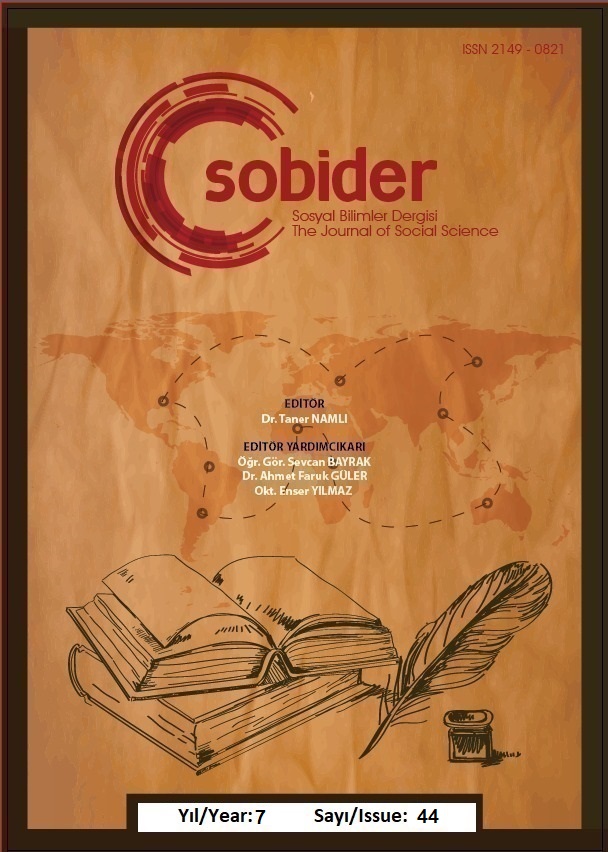SHINING ON THE STAGE: NARCISSISM AND PERFORMING ARTS / İCRADA ÖNE ÇIKMAK: NARSİSİZM VE SAHNE SANATLARI
Author :
Abstract
Narsisizm klinik psikologlar tarafından hayranlık arayışını ve empati yoksunluğunu içeren kişilik bozukluğu olarak tanımlanır. Sosyal psikoloji ise narsisistleri kendine güvenen, liderlik vasıfları olan, kendisiyle aşırı ilgili olan bireyler olarak betimler. Bu çalışmada; narsisizmin faydalarının ve zararlarının irdelendiği, narsisistlerin birbirleriyle olan ilişkilerinin, öfke yönetimlerinin, karar verme süreçlerinin ve tüm bu özelliklerin sanatçıların narsisistik olmalarını teşvik eden performans sanatlarındaki etkilerinin araştırıldığı bir literatür taraması yapılmıştır. Narsisistlerin başkalarıyla olan ilişkileri genellikle zayıftır; eleştirilere ve olumsuz geri bildirimlere karşı saldırgan yaklaşımlarda bulunurlar. Ödül odaklı davranırlar ve aşırı özgüvenden dolayı verdikleri riskli kararlar onları çekici ve aynı zamanda tehlikeli gösterir. Performans sanatçıları narsisizmin olumsuz etkilerini geçersiz kılmak ve daha huzurlu ve sağlıklı bir performans hayatı için öz benliklerini ve mesleki benliklerini birbirinden ayrı tutabilmelidirler.
Keywords
Abstract
Narcissism is defined as a personality disorder by clinical psychologists, who consider narcissists as seekers of admiration with a lack of empathy. According to social psychologists, narcissists are self-assured individuals with leadership traits and excessive interest in themselves. This study makes a literature review to find out about the beneficial and non-beneficial characteristics of narcissists, their relationships, anger management and decision making processes, as well as the reflections of these features on performing arts, which may force artists to be narcissistic. Narcissists’ interpersonal relationships are generally weak and they tend to be aggressive towards criticism and negative feedback. They focus on reward and give risky decisions due to overconfidence, making them attractive and dangerous at the same time. Performers should distinguish between an inner self and a commercial self in order to eliminate the harmful effects of narcissism and to have a more peaceful and healthy performing life.
Keywords
- Ashton, M. C. (2013), Individual Differences and Personality. Academic Press.
- Bleske-Rechek, A., Remiker, M. W., & Baker, J. P. (2008), Narcissistic Men and Women Think They Are So Hot–But They Are Not, Personality and Individual Differences, 45/5, 420424.
- Bronisch, T. (2001), Neurobiologie der Persönlichkeitsstörungen mit Schwerpunkt auf Borderline-Persönlichkeitsstörungen, Psychotherapie, 6/2, 233-246.
- Brunell, A. B., and Buelow, M. T. (2017), Narcissism and Performance on Behavioral Decision‐ Making Tasks, Journal Of Behavioral Decision Making, 30/1, 3-14.
- Buelow, M. T., & Brunell, A. B. (2018), Narcissism and Involvement in Risk-Taking Behaviors, In Handbook of Trait Narcissism, 233-242, Springer, Cham.
- Byrne, K. A., & Worthy, D. A. (2013), Do Narcissists Make Better Decisions? An Investigation of Narcissism and Dynamic Decision-Making Performance, Personality and Individual Differences, 55/2, 112-117.
- Campbell, W. K., Hoffman, B. J., Campbell, S. M., & Marchisio, G. (2011), Narcissism in Organizational Contexts, Human Resource Management Review, 217/4, 268-284.
- Carlson, E. N. (2013), Honestly Arrogant or Simply Misunderstood? Narcissists’ Awareness of Their Narcissism, Self and Identity, 12/3, 259-277.
- Dionne, M. M., & Davis, C. (2012), Body Image and Personality, In T. F. Cash (Ed.), Encyclopedia of Body Image and Human Appearance, 135–140, Elsevier Academic Press.
- Emmons, R. A. (1987), Narcissism: Theory and Measurement, Journal of Personality and Social Psychology, 52/1, 11.
- Fatfouta, R., Rentzsch, K., & Schröder-Abé, M. (2018), Narcissus Oeconomicus: Facets of Narcissism and Socio-Economic Decision-Making, Journal of Research in Personality, 75, 12-16.
- Guedes, M. J. C. (2016), Mirror Mirror on the Wall, Am I the Greatest Performer of All? Narcissism and Self-Reported and Objective Performance, Personality and Individual Differences, 108, 182-185.
- Higgs, M., (2009), The Good, The Bad and the Ugly: Leadership and Narcissism, Journal of Change Management, 9/2, 165-178.
- Jordan, A. H., Audia, P. G. (2012), Self-Enhancement and Learning From Performance Feedback, Academy of Management Review, 37/2, 211-231.
- Lakey, C. E., Rose, P., Campbell, W. K., Goodie, A. S. (2008), Probing the Link Between Narcissism and Gambling: The Mediating Role of Judgment and Decision-Making Biases, Journal of Behavioral Decision Making, 21/2, 113-137.
- Lamkin, J., Lavner, J. A., & Shaffer, A. (2017), Narcissism and Observed Communication in Couples, Personality and Individual Differences, 105, 224-228.
- Linden, P. (2010), Coping with Narcissism: Causes, Effects, and Solutions for the Artist Manager, Scholarship and Professional Work – Communication, 135.
- Martinsen, Ø. L., (2011), The Creative Personality: A Synthesis and Development of the Creative Person Profile, Creativity Research Journal, 23/3, 185-202.
- Martinsen, Ø. L., Arnulf, J. K., Furnham, A., & Lang-Ree, O. C. (2019), Narcissism and Creativity, Personality and Individual Differences, 142, 166-171.
- Morf, C. C., Rhodewalt, F. (2001), Unraveling the Paradoxes of Narcissism: A Dynamic Self- Regulatory Processing Model, Psychological Inquiry, 12/4, 177–196.
- Morf, C. C., Horvath, S. (2010), Self-Regulation Processes and Their Signatures, In: Hoyle, R., editor, Handbook of Personality and Self-Regulation, Malden, MA: Blackwell, 117144.
- Nevicka, B., Baas, M. & F. S. T. Velden (2015), The Bright Side of Threatened Narcissism: Improved Performance Following Ego Threat, Journal of Personality, 84/6, 809-823.
- Saß, H. (2001), Personality Disorders, Contemporary Psychiatry, 1975-2007, Springer, Berlin, Heidelberg.
- Shulman, R. B. (2015), The Psychiatric Approach to Headache, In Headache and Migraine Biology and Management, 223-238, Academic Press.
- Wallace, H. M., & Baumeister, R. F. (2002), The Performance of Narcissists Rises and Falls With Perceived Opportunity For Glory, Journal of Personality and Social Psychology, 82/5, 819.
- Wallace, A. S. (2015), Save Your Self: The Role of Narcissism and Political Skill In the Relationship Between Ego Threat and Performance-Related Outcomes, Doctor of Philosophy Dissertation, State University of New York at Buffalo, ProQuest Dissertations Publishing.
- Yang, Z., Sedikides, C., Gu, R., Luo, Y. L. L., Wang, Y., Cai, H., (2018), Narcissism and Risky Decisions: A Neurophysiological Approach, Social Cognitive and Affective Neuroscience, 13/8, 889–897.
- Young, S. M., & Pinsky, D. (2006), Narcissism and Celebrity, Journal of Research In Personality, 40/5, 463-471.
